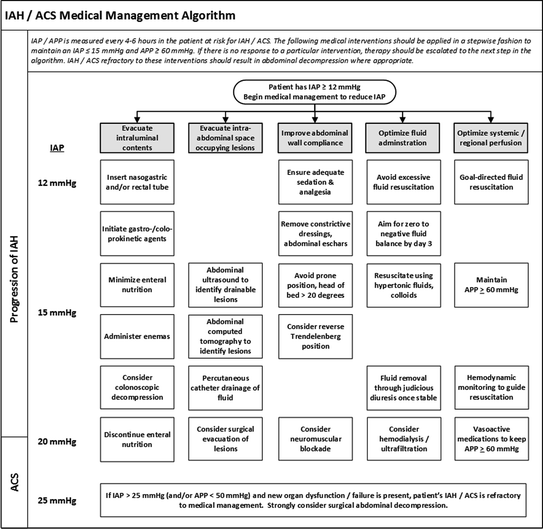Organ system
Pathophysiologic effects
Clinical manifestations
Threshold IAP (mmHg)
Cardiovascular
Decreased preload/venous return
Increased afterload
Compression of inferior vena cava
Decreased cardiac output
Increased susceptibility to hypovolemia
10
Pulmonary
Increased intrathoracic pressure
Cephalad elevation of diaphragm
Extrinsic compression of pulmonary parenchyma
Alveolar atelectasis
Increased airway resistance
Hypoxemia
Hypercarbia
Elevated airway pressures
Increased intrapulmonary shunt
Increased alveolar dead space
15
Renal
Decreased renal blood flow
Renal vein compression
Renal parenchymal compression
Oliguria
Anuria
Acute renal failure
15
Gastrointestinal
Decreased mesenteric blood flow
Intestinal ischemia
Bacterial translocation/sepsis
Increased susceptibility to hypovolemia
Increased visceral edema/capillary leak
Metabolic acidosis
10
Hepatic
Decreased hepatic vein blood flow
Decreased portal vein blood flow
Hepatic dysfunction/failure
Metabolic acidosis
10
Central nervous system
Increased intrathoracic pressure
Decreased cerebral venous outflow
Increased intracranial pressure
Decreased cerebral perfusion pressure
15
Abdominal wall
Decreased abdominal wall compliance
Decreased rectus sheath blood flow
Fascial dehiscence
10
Finally, the severity of IAP is less important than the duration of IAH [8]. Prolonged elevations in IAP result in organ dysfunction and failure that can have a significant impact upon the patient morbidity and mortality. Every effort should be made to reduce the period of time that a patient’s IAP exceeds 15 mmHg. The duration of IAH correlates significantly with the increased ICU and hospital length of stay, duration of mechanical ventilation, enteral nutrition intolerance, and mortality. For these reasons, primary fascial closure in the presence of marked visceral edema or abdominal contamination is rarely appropriate and only leads to the need for emergent abdominal decompression, prolonged critical illness, organ dysfunction, and increased healthcare costs.
Prevention of IAH/ACS
When faced with a patient demonstrating risk factors for IAH/ACS, such as intestinal ischemia or abdominal sepsis, the acute care surgeon must decide intra-operatively whether to correct the patient’s pathology through either a single, initial procedure or a staged approach. This decision is based upon the answers to three questions:
- 1.
Is the patient too ill to tolerate a single procedure/definitive repair?
- 2.
Can the patient tolerate the postoperative IAH that will accompany primary fascial closure without developing ACS?
- 3.
Can the source of contamination be safely controlled using a single procedure?
The well-known principles of damage control, as applied to the traumatically injured, are directly applicable to the acute care surgery patient as well. As a result of delayed presentation, under-resuscitation, advanced organ dysfunction/failure, and pre-existing medical comorbidities, some patients are better served by a staged laparotomy approach with the maintenance of an “open abdomen” and temporary abdominal closure until their physiology has improved, and they can tolerate definitive repair. A “single-procedure” approach, in the presence of critical illness, is rarely the correct answer and frequently results in increased morbidity and mortality. The methods for performing such a staged approach are described below.
All patients with intestinal ischemia are at risk for postoperative IAH. Inappropriate primary fascial closure of those patients at significant risk will increase IAP through the mechanisms described in Table 6.1 and result in worsening end-organ dysfunction and failure. This commonly results in a vicious cycle of visceral edema, intestinal malperfusion, and increasing IAP that ultimately culminates in the development of ACS and need for emergent decompressive laparotomy. The keys to avoiding this runaway cascade of progressive shock and organ failure are appropriate end-organ resuscitation (described below) and staged laparotomy in patients at significant risk.
Abdominal sepsis and contamination are significant risk factors for visceral edema and subsequent IAH/ACS. Abdominal contamination initiates a pro-inflammatory cytokine cascade that promotes further visceral edema and elevated IAP. While early primary fascial closure places the patient at risk for IAH/ACS, staged laparotomy and evacuation of cytokine-rich fluid from the abdominal cavity through a temporary abdominal closure help to modulate and downgrade the pro-inflammatory response, improving organ dysfunction and patient survival (Fig. 6.1).


Fig. 6.1
The evolution of IAH/ACS: IAP intra-abdominal pressure; APP abdominal compartment syndrome; IAH intra-abdominal hypertension; ACS abdominal compartment syndrome
Management of IAH/ACS
While surgical decompression is widely and erroneously considered the only treatment for IAH/ACS, non-operative medical management strategies play a vital role in both the prevention and treatment of IAP-induced organ dysfunction and failure (Fig. 6.2) [7]. Appropriate management of IAH/ACS is based upon four general principles:


Fig. 6.2
Medical management of IAH/ACS: IAP intra-abdominal pressure; APP abdominal compartment syndrome; IAH intra-abdominal hypertension; ACS abdominal compartment syndrome
- 1.
Serial monitoring of IAP
- 2.
Optimization of systemic perfusion and end-organ function
- 3.
Institution of specific medical interventions to reduce IAP and the end-organ consequences of IAH/ACS
Stay updated, free articles. Join our Telegram channel

Full access? Get Clinical Tree








